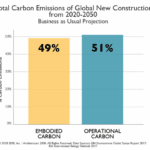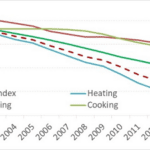Topic: Embodied Carbon- Why it’s important for Architects and Project Owners to consider embodied carbon in buildings during the planning, design and construction process.
Definitions:
- Embodied Carbon is most simply stated as the CO2 emissions from building materials and is measured in metric tons of CO2e.
- Operational Carbon is the CO2 emissions from the operation of the building such as the energy required for heating, cooling, lighting and equipment, etc.
Facts:
- For years now, our buildings have continued to be more energy efficient as time passed. This happened predominately due to the development and adoption of better energy codes.
Consider the global warming potential in the operations of the buildings we design and construct today. Building Operations are responsible for 28% of Global CO2 emissions.
So, do basic code compliant buildings cut the mustard anymore?
A code compliant building cost more to operate over its expected life in comparison to a Net-Zero building

The graph plots the estimated cost of operation for a code compliant building and for the same building with the Net-Zero features actually incorporated. It shows the cost savings after 20 years. Added cost of the net-zero features are financed with the building and accounted for in the savings. Project study published by Maclay Architects.
Consider the embodied carbon that goes into the construction of a typical new building.

The graph shows that over the life of the building 40% of emissions are from operations and 60% are from the construction. Understand that emissions from construction occur when the building is first constructed with some additional emissions from renovations during its full life span. The graph also indicates that at 20 years about 10% of emissions are from operations and 90% is from embodied carbon.
Calculating embodied carbon in construction is inexact. The point of going thru the process of the accounting is to find the low hanging fruit and identify the largest carbon contributors and then to attempt to make the best reductions we can. And of course it’s always a good choice to reuse existing buldings if possible and to generally use less stuff in our designs.
Conclusion:
Cutting Embodied Carbon from the building process is more crucial over the next 20 years, even as building energy use approaches Net Zero. In order to meet the reductions in greenhouse gases required by various 2030, 2040 and 2050 global timetables cutting Embodied Carbon must be a priority for architects.
Links to graphs provided
https://www.maclayarchitects.com/net-zero-net-postive-energy.php
https://architecture2030.org/buildings_problem_why/









